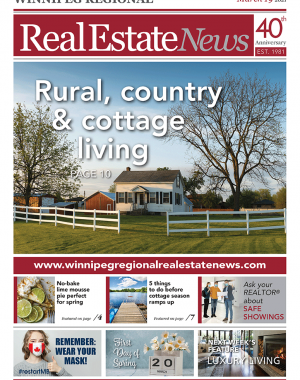By Michael Robinson
As the lead planner behind the drafting of the City of Winnipeg’s companion document to OurWinni-peg 2045, Complete Communities Direction Strategy 2.0 (CCDS 2.0), Michael Robinson has been very amenable and approachable to our Board to discuss this key planning document. CCDS 2.0 is a long term blue-print on how we need to grow in a fiscally sustainable and environmentally responsible way. To this end, and we have certainly spoken about its importance to future development, a key direction is growing up, not just out with a 50% residential intensification target in the built up areas of Winnipeg. In respect to the other 50% — greenfields — an urban structure map has been created which directs new development to align better with capital budgets and new planned infrastructure service requirements — Peter Squire
In Manitoba, all municipalities are required to prepare a development plan that sets out long term plans and policies for its physical, social, environmental and economic objectives.
In Winnipeg, the development plan is accompanied by a more detailed secondary plan that focuses on the physical environment. OurWinnipeg 2045 is the City of Winnipeg’s development plan. The Complete Communities Direction Strategy 2.0 (Complete Communities 2.0) is a citywide secondary plan that guides growth, development and land use in the City of Winnipeg.
OurWinnipeg 2045 and Complete Communities 2.0 have been informed by almost three years of public and stakeholder engagement as well as extensive forecasting and background research.
In public engagement for the OurWinnipeg 2045 and Complete Communities 2.0 update, Winnipeggers said they want to:
• Be more strategic in how we grow
• Maximize existing infrastructure and services by accommodating growth in existing communities through context-sensitive infill and mixed-use
development
• Ensure every neighbourhood has a range of housing types available, so that every person or family can find a place to live that meets their needs
• Increase the range of transportation options — such as walking, cycling, and transit — to meet people’s daily needs
• Live in complete communities, where people of every age and ability have the opportunity to live, work and play within their own neighbourhood
• Focus our energy on implementing these goals and “making the plan work.”
Forecasting shows Winnipeg will continue to grow and change considerably over the coming
decades. By 2040, our city is expected to grow by more than 160,000 people, add more than 83,000 new jobs, and require approximately 82,000 new dwelling units.
Opportunities and challenges come with this continuing growth. As a city, we have an opportunity to be proactive, strategic and innovative about how we grow and change.
This will allow us to answer the following questions in a better way:
• How do we ensure that the City has a diversified revenue base that can pay for the infrastructure and services to support it?
• How are we going to sustainably accommodate growth and change while still meeting our climate targets?
• How can be capitalize on growth while making sure our city stays livable, affordable and desirable?
• How can we make sure all Winnipeggers benefit from this growth?
• How can we maintain and enrich what we value most while finding room for a growing population?
Complete Communities 2.0 maintains the same vision and principles that guided the first Complete Communities Direction Strategy (adopted as By-law in 2011). At the same time, Complete Communities 2.0 puts greater focus on clarity, implementation and making the plan function better.
Highlights
Complete Communities 2.0 is introducing three key directions in order to be more strategic about how we grow and the best implement complete communities’ principles.
• It is targeting that a minimum of 50% of all new dwelling units be accommodated in the existing built-up area of the city. It seeks to achieve this by making infill development easier, more desirable and more predictable.
• It more explicitly directs the highest residential and employment densities to the best transit to
enhance the viability of sustainable transportation.
• It provides more direction regarding the management of greenfield land to enhance the certainty and timeliness of capital infrastructure and local area plan delivery.
In addition, Complete Communities 2.0 provides further direction on:
• Reinforcing Downtown as the city’s destination of choice and preeminent complete community.
• The City’s financing of growth and development.
• The accommodation of infill development in
Established Neighbourhoods.
• Managing commercial lands to maintain and
enhance the vibrancy of existing areas.
• Managing industrial lands to promote City competitiveness, protect existing businesses, and mitigate land use conflicts.
At the crux of Complete Communities 2.0 is a residential intensification target. Consistent with the City’s Climate Change Action Plan, the intensification target states that a minimum of 50% of all new dwelling units be accommodated in the intensification target area of the City. The intensification target area includes areas that have infrastructure, services and amenities in place to support the infilling of these neighbourhoods, including the Downtown, Corridors, Major Redevelopment Sites, older neighbourhoods across the City (called Mature Communities in CCDS 2.0), and more recent communities that are fully developed.
To achieve this target, the City will need to expend considerable effort in making new development in these areas easier, more desirable, and more predictable.
At the same time, greenfield development will also play an important part in accommodating growth. Greenfield land, due to large parcel sizes, can accommodate many dwelling units in a reliable and predictable way.
Ensuring there are opportunities available for both infill and greenfield development gives people options when they are deciding where to live and what type of housing suits their needs.
Overall, thousands of Winnipeggers contributed towards the OurWinnipeg 2045 and Complete Communities 2.0 review process through both in-person and online opportunities. The public will have one more chance to comment when the plans are considered at a public hearing in the near future.
To view or download the OurWinnipeg 2045 and Complete Communities 2.0 documents please go to www.winnipeg.ca/interhom/CityHall/OurWinnipeg
Michael Robinson, MCIP, RPP, AACI, is the Senior Planner for the City of Winnipeg



